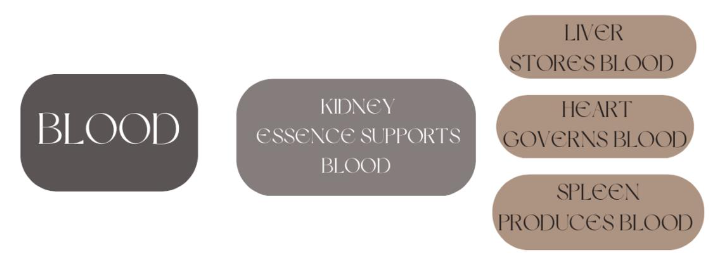Women’s Menstrual Health
How the concept of Blood in Chinese Medicine plays a role in Women’s Health.
In traditional Chinese Medicine (TCM), blood is considered to be an essential substance in the overall functioning of the body. The main function of blood is to provide nourishment and moistening to the body’s tissues and sinews (Maciocia, 2015). According to Maciocia (2015), the relationship between Qi and blood is a close one: Qi is the commander of blood and blood is the mother of Qi. Therefore, one cannot exist without the other. This means that in cases of pathology, if Qi is deficient then blood may become deficient and vice versa.
The female reproductive cycle & blood
The female reproductive cycle is deeply connected to the relationship between Qi and blood as well as the internal organs that function to store, produce and govern blood. Research suggests that common gynaecological disorders such as endometriosis, polycystic ovarian syndrome (PCOS), uterine fibroids, pre-menstrual syndrome (PMS), dysmenorrhoea and menopause are connected to TCM pathological concepts of blood (Cochrane et al., 2014). In terms of TCM pathology, blood can be deficient, stagnant or hot (Maciocia, 2015). The relationships between the Zang-Fu contribute to the functioning and pathology of blood. These organs are the Liver, Kidney, Spleen and Heart. Therefore, the functioning of these organs are essential to the maintenance and production of blood. Common TCM pattern syndromes that are common in gynaecological disorders are blood deficiency, blood stagnation and yin deficiency which can develop from disorders in the blood (Zhou & Qu, 2009). A gynaecological condition such as endometriosis is considered to be associated with blood stasis and TCM may be used in some cases to provide pain relief (Hung et al., 2021).
What happens in blood pathology from a TCM perspective?
Several factors may contribute to the development of blood pathology in Women. These factors are excessively overworking, excessive sexual activity, emotional factors and irregular diet (Maciocia, 2011). Therefore, the following presentations may occur in blood pathologies. Blood deficiency manifests in menstrual function with scanty periods and amenorrhoea. Blood stasis manifests with sharp pain, which is seen in conditions like dysmenorrhea or endometriosis (Maciocia, 2011). Lastly, blood heat may cause heavy periods and contribute to skin disorders. If you have identified with any of the symptoms above, further investigation may be required and TCM may be able support you.
Ways to support the blood through TCM
TCM can be used in various ways to support Blood, whether it be through TCM manual therapies such as Acupuncture, Chinese herbal medicine or TCM dietary therapy. Research has indicated that acupuncture may influence female reproductive functioning, however, the mechanisms by which this occurs are not fully understood (Cochrane et al., 2014). Through the use of acupuncture, herbs and dietary therapy, blood can be tonified if deficient, cooled if hot and moved if stagnant. In a recent study on Chinese Herbal Medicine for female infertility, it determined that herbal medicine and Chinese dietary therapy was successful in supporting Women in conjunction with IVF and other fertility treatments (Reid, 2015). This suggests that TCM herbs and dietetics may prove to be beneficial in supporting conventional medicine in the treatment of the symptoms associated with reproductive disorders such as pain. Overall, if you are experiencing symptoms related to your reproductive health, research suggests that TCM may be beneficial in providing pain relief and management.
Research – Find out more
The following research articles have been used to support the content of this blog post. Click on the links to find out more:
1. A review on the treatment of gynaecological disorders with TCM.
References:
Cochrane, S., Smith, C. A., Possamai-Inesedy, A., & Bensoussan, A. (2014). Acupuncture and women’s health: an overview of the role of acupuncture and its clinical management in women’s reproductive health. International Journal of Women’s Health, 6, 313-325. https://doi.org/10.2147/IJWH.S38969
Hung, H. H., Lai, J. N., Chen, W. C., Chen, Y. H., Chiu, L. T., & Chen, H. Y. (2021). Evaluation of the efficacy of traditional Chinese medicine for the productive and pregnancy outcomes in women with endometriosis: a nationwide population-based study. Taiwanese Journal of Obstetrics and Gynaecology, 60 (4), 685-689. https://doi.org/10.1016/j.tjog.2021.05.017
Maciocia, G. (2011). Obstetrics and gynaecology (2nd ed.). Elsevier.
Maciocia, G. (2015). The foundations of Chinese medicine (3rd ed.). Elsevier.
Reid, K. (2015). Chinese herbal medicine for female infertility: an updated meta-analysis. Complementary Therapies in Medicine, 23 (1), 116-128. https://doi.org/10.1016/j.ctim.2014.12.004
Zhou, J., & Qu, F. (2009). Treating gynaecological disorders with traditional Chinese medicine: a review. African Journal of Traditional, Complementary and Alternative Medicines: AJTCAM, 6 (4), 494-517. https://doi.org/10.4314/ajtcam.v6i4.57181
Article lasted edited and reviewed 14/07/2025
By Annie Crosby


